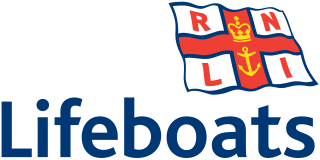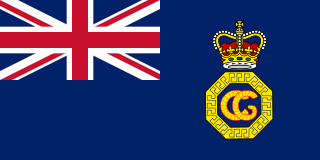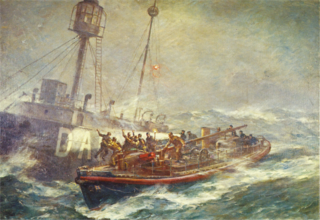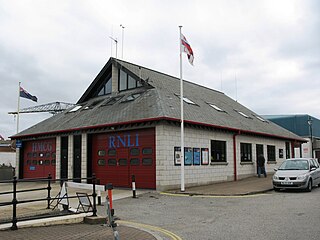Related Research Articles

The Royal National Lifeboat Institution (RNLI) is the largest charity that saves lives at sea around the coasts of the United Kingdom, the Republic of Ireland, the Channel Islands, and the Isle of Man, as well as on some inland waterways. It is one of several lifeboat services operating in the same area.

Her Majesty's Coastguard (HMCG) is a section of the Maritime and Coastguard Agency responsible, through the Secretary of State for Transport to Parliament, for the initiation and co-ordination of all maritime search and rescue (SAR) within the UK Maritime Search and Rescue Region. This includes the mobilisation, organisation and tasking of adequate resources to respond to persons either in distress at sea, or to persons at risk of injury or death on the cliffs or shoreline of the United Kingdom. It is also responsible for land based search and rescue helicopter operations from 2015.

The Penlee lifeboat disaster occurred on 19 December 1981 off the coast of Cornwall, England. The Royal National Lifeboat Institution (RNLI) lifeboat Solomon Browne, based at the Penlee Lifeboat Station near Mousehole, went to the aid of the vessel Union Star after its engines failed in heavy seas. After the lifeboat had rescued four people, both vessels were lost with all hands; sixteen people died, including eight volunteer lifeboatmen.

Henry George Blogg GC BEM was a lifeboatman from Cromer on the north coast of Norfolk, England, and the most decorated in Royal National Lifeboat Institution (RNLI) history.
Since its inception, the Royal National Lifeboat Institution (RNLI) has provided lifeboats to lifeboat stations in the United Kingdom and Ireland.
RNLB Mary Stanford was a Royal National Lifeboat Institution (RNLI) Liverpool-class lifeboat stationed in Rye Harbour.
Stuart Hill, is an English pensioner. He was dubbed "Captain Calamity" in 2001 after he needed to be rescued from multiple misadventures while sailing. He later moved to the Shetland Islands where he took to protesting around constitutional matters. In 2008 he made claims relating to the formation of a micronation which he called the Sovereign State of Forvik. His disputes led to several court appearances. He was convicted of road traffic offences, vandalism and declared bankrupt. Hill unsuccessfully stood for election to Orkney and Shetland as an Independent in the 2017 UK general election where he came last.

RNLB Mary Stanford was the Ballycotton Lifeboat from 1930 to 1959. Ballycotton is on Ireland's southern coast, a trade route to the Americas. There are many dangerous rocks and shallows with on-shore prevailing winds. Ballycotton has a long tradition of life-saving. Mary Stanford had 41 rescues, or "shouts", and saved 122 lives. She performed the notable Daunt Lightship rescue on 11 February 1936. After her withdrawal from service she lay for some years in a backwater of Dublin's Grand Canal Dock, but has now been returned to Ballycotton and restored.

Athena is a 7,805 GT factory ship which was built in 1992. In October 2010, she caught fire off the Isles of Scilly. In May 2011 she caught fire while lying at the harbour of Runavík in Skálafjørður, Faroe Islands. It happened at night, and people who lived on the other side of the fjord, where the smoke was headed, were evacuated. Some months later the ship was sold to Smedegaarden in Esbjerg, which took her apart.

Falmouth Lifeboat Station is the base for Royal National Lifeboat Institution (RNLI) search and rescue operations at Falmouth, Cornwall in the United Kingdom. The first lifeboat was stationed in the town in 1867 and the present station was opened in 1993. It operates a Severn Class all-weather Lifeboat (ALB) and an Atlantic 85 inshore lifeboat (ILB).

Burnham Area Rescue Boat (BARB), also known as BARB Search & Rescue, is a voluntary independent search and rescue service, formed in 1992 in Burnham-on-Sea, Somerset that operates two rescue hovercraft and two inshore rescue boats in the Bridgwater Bay area. It is also a registered charity.

NCI Froward Point is a busy National Coastwatch Institution (NCI) lookout station at Inner Froward Point at the easterly side of the mouth of the River Dart two miles by coast path from Kingswear in Devon in England. Its twin duties are to maintain an hours of daylight watch over the local coastal area and the South West Coast Path on whose route it lies. With some significant blind spots because of the coastline, NCI Froward Point covers the coastline from Start Point in the West towards Brixham in the East.

Salcombe Lifeboat Station is the base for Royal National Lifeboat Institution (RNLI) search and rescue operations at Salcombe, Devon in England. The first lifeboat was stationed in the town in 1869. The Salcombe Lifeboat has twice capsized, in 1916 with the loss of 13 lives, and in 1983 with no loss of life. Since 2008 the station has operated a Tamar-class all weather boat (ALB) and an Atlantic 75 inshore lifeboat (ILB).

Palling Volunteer Rescue Service was originally an independent, voluntary-manned and charitably-funded inshore rescue service located in the village of Sea Palling in North Norfolk, England. First established by private funds in 1840, it was taken over by the Royal National Lifeboat Institution (RNLI) in 1858 and operated until 1931, when it was closed in a rationalisation of regional lifeboat stations. Revived in 1974 by local people through monies raised from private, business and charitable donations, today the charitable Sea Palling Independent Lifeboat, runs a single 5.7-metre (19 ft) Ocean Pro RIB, an Arancia ILB and a shoreline rescue quad bike, all covering the area between Eccles-on-Sea and Winterton-on-Sea.

Cardigan Lifeboat Station, at Poppit Sands, North Pembrokeshire, near Cardigan, Ceredigion, Wales, is a Royal National Lifeboat Institution (RNLI) lifeboat station opened in 1849. The station closed in 1932 but reopened in 1971 as an inshore lifeboat station.

Jersey Coastguard is responsible for the safety of life at sea along with the security and protection of the maritime environment for Jersey’s territorial waters. The service is provided by the Ports of Jersey from the Maritime Operations Centre in Maritime House in the port of St Helier, Jersey.

Portishead Lifeboat Station opened in 1995 as Portishead Lifeboat Trust, an independent lifeboat operating from Sugar Loaf Bay. It was adopted by the Royal National Lifeboat Institution (RNLI) in 2015 when a new lifeboat station was opened adjacent to Portishead Pier.

Southport Offshore Rescue Trust (SORT) is the registered charity that runs the Southport Independent Lifeboat, a marine and land based search and rescue organisation on the Sefton coastline.

Hope Cove Life Boat was formed in 1878 and is a voluntary search and rescue service that operates an inshore rescue boat in the Bigbury Bay area.

Whitby Lifeboat Station is a Royal National Lifeboat Institution (RNLI) lifeboat station located in Whitby, North Yorkshire, England. It is one of nine situated along the Yorkshire coast. Whitby has had a lifeboat station since 1802, with the RNLI responsible since 1861. In its 200 plus year history, Whitby has had five different lifeboat stations. A sixth lifeboat and station was located at Upgang, just up the coast from Whitby, and whilst it was considered separate from Whitby, it was crewed by men from the Whitby lifeboat.
References
- 1 2 agencies, James Sturcke and (2008-06-14). "Rescuers recover stricken transatlantic rowers". the Guardian. Retrieved 2022-04-28.
- 1 2 3 BBC. "Scilly Boys Update". www.bbc.co.uk. Retrieved 2022-04-28.
- ↑ "'Scilly Boys' Aim To Break Trans-Atlantic Rowing Record". www.nysun.com. Retrieved 2022-04-28.
- 1 2 "Woodvale North Atlantic Challenge 2008 – 4 Scilly Boys row4home". 2008-09-15. Archived from the original on 2008-09-15. Retrieved 2022-04-28.
- ↑ "Woodvale North Atlantic Challenge 2008 - 4 Scilly Boys row4home". 2008-09-15. Archived from the original on 2008-09-15. Retrieved 2022-04-28.
- ↑ "Home to a welcome ceremony for Scilly boys". Falmouth Packet. Retrieved 2022-04-28.
- ↑ "BBC Two - An Island Parish, The Deadly Storm". BBC. Retrieved 2022-04-29.